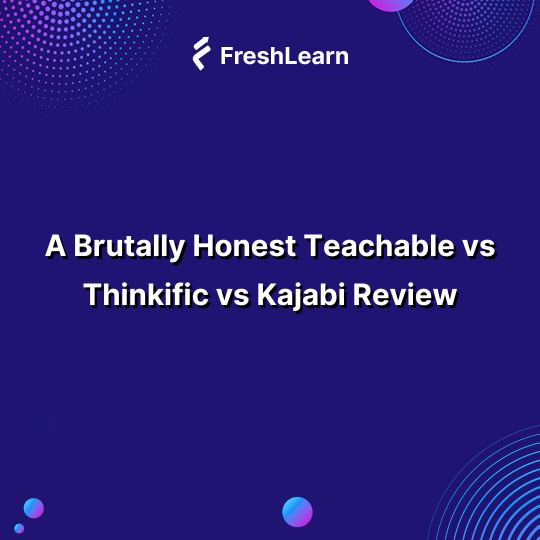
A Brutally Honest Teachable vs Thinkific vs Kajabi Review
When most creators start comparing Teachable, Thinkific, and Kajabi, they expect an easy answer (I did, too).
- Teachable promises a simple path to launching your first course.
- Thinkific leans into flexibility and lets you structure lessons and assessments as you see fit.
- Kajabi positions itself as the all-in-one system for creators who want everything in one place.
But choosing between them isn’t as straightforward as those pitch lines make it sound. In fact, there are too many pricing tiers, feature charts, and bold claims that don’t line up once you look closer.
It didn’t take long to see why so many creators get stuck here. They weren’t confused by technology, but by the trade-offs hidden in plain sight.
If that sounds familiar, this guide is for you. I’ll break down how each platform really works in practice — and introduce a fourth option that fixes what the “big three” miss.
Teachable vs Thinkific vs Kajabi: 5-second verdict
The feature showdown: Teachable vs. Thinkific vs. Kajabi
Let’s break down how each tool handles the essentials (building courses, delivering them to students, running your marketing, and designing your site), so you can see exactly where they stack up and where they fall short.
TL;DR: Teachable vs Thinkific vs Kajabi
Pricing and cost
Sticker prices don’t tell the full story. Transaction fees, product limits, and hidden add-ons can completely change what you actually pay. Let’s break it down platform by platform.
Here’s what you get at entry level across all three platforms:
Teachable’s pricing
Teachable dropped its free plan. Now, it starts at $39/month (Starter) or $29/month if billed annually, but here’s the kicker
- 7.5% transaction fee on the Starter plan.
- You’re also limited to one published product and just 100 students.

That means if you sell 100 courses at $99 each ($9,900 gross revenue), you’ll spend over $742.50 in Teachable fees on top of Stripe/PayPal card fees (2.9% + $0.30 each transaction = $287).
💡 Your real take-home on $9,900 in sales: about $8,870. That’s over $1,000 lost on a single small launch (before ad spend or taxes).
If you upgrade to the Builder plan ($89/month), Teachable drops the transaction fee to 0%. But that’s more than double the Starter’s cost, and you’re still capped at 5 published products and 1,000 students.
Users complain about the jump from $39 to $69 with no major new features. It shows this pain is very real for small creators.
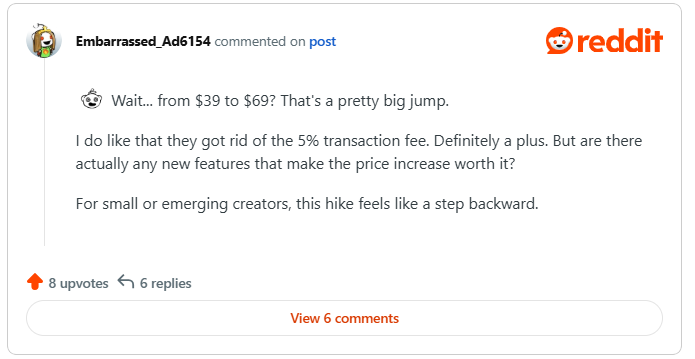
By the Growth plan ($189/month), Teachable starts to feel more reasonable: 25 products, no student cap, white-labeling, and custom admin roles. The Advanced plan ($399/month) unlocks 100 products and unlimited integrations.
But the catch is obvious: Teachable feels cheap at first glance, but unless you’re fine with limits and fees eating into your sales, you’ll move off the Starter tier fast.
For a plan-by-plan breakdown of the platform’s pricing, read our comprehensive guide on Teachable pricing.
Thinkific’s pricing
Thinkific positions itself as the predictable option. Plans start at $49/month (Basic) or $36/month if billed annually. Unlike Teachable, you get:
- Unlimited courses and students from day one.
- 0% platform transaction fees.
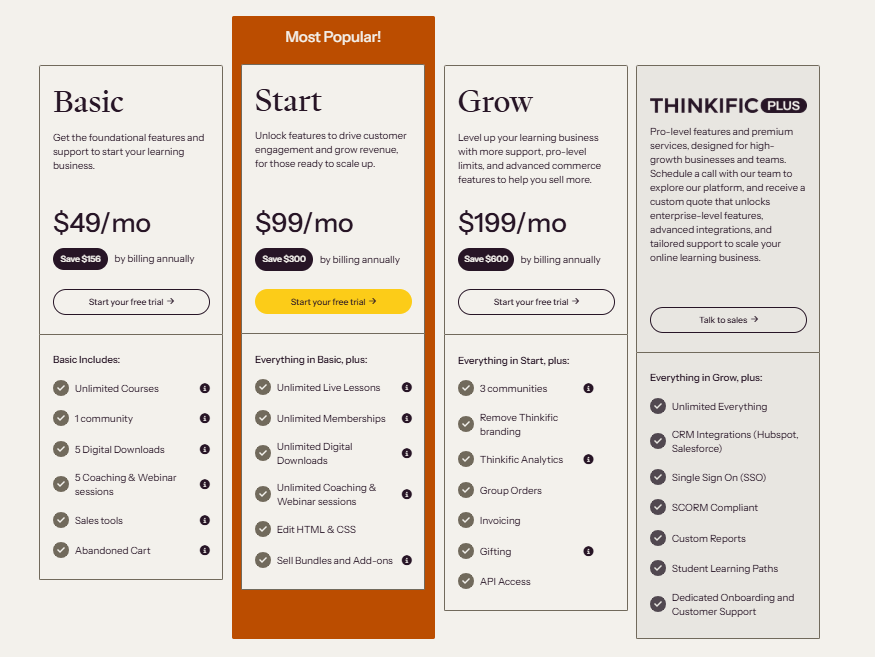
Sounds clean, but there’s a trap: if you don’t use Thinkific Payments, you’ll pay a penalty fee. That’s 5% on Basic, 2% on Start ($99/month), and 1% on Grow ($199/month).
Creators have also voiced frustration with Thinkific’s limitations.
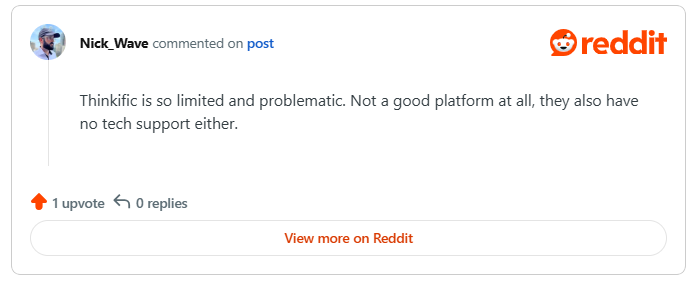
So let’s run the same $9,900 sales example:
- On Basic with Stripe/PayPal, that’s $495 in Thinkific penalty fees, plus approximately $287 in Stripe card fees, which totals $782 lost.
- Suddenly, your “$49 plan” feels more like $114/month when factored in.
- Add Zapier automations ($20/month) and maybe a custom domain ($1.50/month annualized), and your true monthly cost is closer to $135.
By choosing Start ($99/month), you avoid the 5% fee if you stick with Thinkific Payments. That plan also unlocks live lessons, memberships, downloads, and custom code editing, basically the baseline for any serious creator.
Grow ($199/month) adds analytics, multiple communities, group orders, invoicing, and API access. At this level, Thinkific competes directly with Teachable's Growth plan.
The math shows Thinkific’s biggest win is unlimited courses and students at the entry level, but you must commit to their payment rails to avoid penalty fees.
We’ve put together a detailed analysis of all their pricing plans. Head over to our updated Thinkific pricing guide to see what you get and what you won’t.
Kajabi’s pricing
Kajabi is the most expensive on paper. The new Kickstarter plan starts at $89/month (or $71 billed annually). The tiers climb quickly:
- Basic: $149/month (or $119 annually)
- Growth: $199/month (or $159 annually)
- Pro: $399/month (or $319 annually)
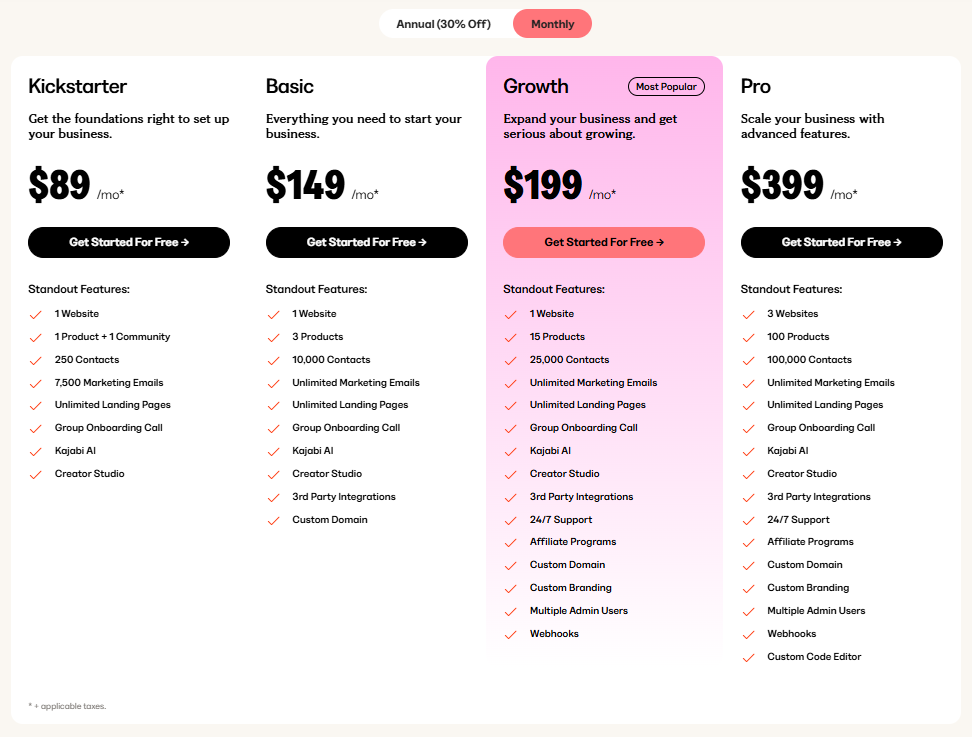
At first glance, that’s double or triple the cost of Teachable and Thinkific.
But Kajabi’s strength is bundling: email marketing, automations, funnels, landing pages, and affiliate management are all included.
If you were paying for ConvertKit ($29+), Rewardful ($49), Zapier ($20+), and hosting ($10), you’d already be adding $100+ elsewhere.
Let’s run the $9,900 sales example:
- Kajabi charges no transaction fees (you still pay Stripe/PayPal approximately $287).
- Your take-home: $9,613.
- Compared to Teachable Starter ($8,870) or Thinkific Basic on Stripe ($9,118), Kajabi already offers more value, even though the monthly price is higher.
Where Kajabi gets tricky is in contact limits. Outgrow 250 contacts on Kickstarter and you’re forced to upgrade to the $149 Basic plan, even if you don’t need the extra features. Add-ons like branded mobile apps ($89–199/month) or Kajabi Access ($99/month) also inflate the bill.
That sticker shock is also a common complaint.
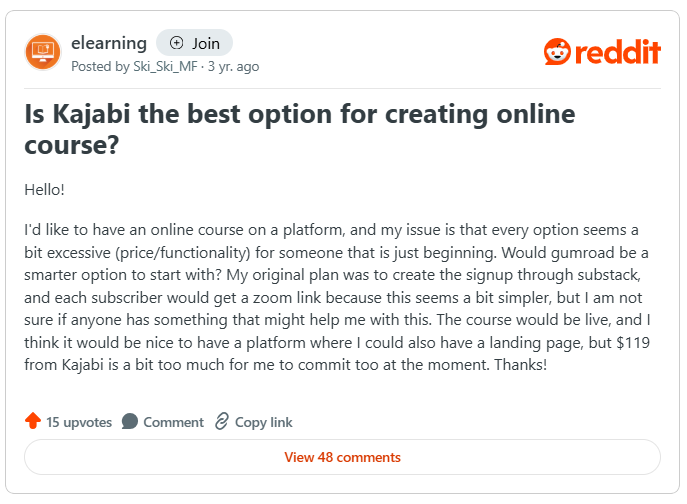
Still, Kajabi’s strength is predictability. You know your flat fee covers most of what you’ll need to run a business. Kajabi is predictable for established businesses, but a tough entry point for lean beginners.
Our Kajabi pricing guide dives into the plan-wise pricing and TCO beyond sticker price in detail.
Total Cost of Ownership across Teachable vs Thinkific vs Kajabi
Now, let’s factor in every cost you’ll incur to calculate how much you’ll actually end up paying.
Here’s a quick framework for you to decide:
- Teachable: cheapest looking sticker, but Starter fees + external tools (email, affiliates, mobile app) make it the priciest once you’re running a business.
- Thinkific: unlimited courses/students included, but the penalty fee if you skip Thinkific Payments plus common add-ons almost triples the entry price.
- Kajabi: highest base fee, but bundles email, automations, affiliate tracking, and site hosting. Even with common add-ons, total outflow is often lower than that of Teachable/Thinkific.
Course creation and student experience
After cost, the real question is what it’s like to actually build and deliver courses: how intuitive the tools feel, and how much control you get over the student experience. Let’s compare those aspects.
Teachable’s Course Builder
Teachable is built for speed. Upload your video, PDF, or audio, and you can have a first draft of your curriculum live in hours. Its AI tools make it even faster by generating outlines, quizzes, and transcripts from just a short course description.
For beginners, this feels like a shortcut past the blank-page problem.
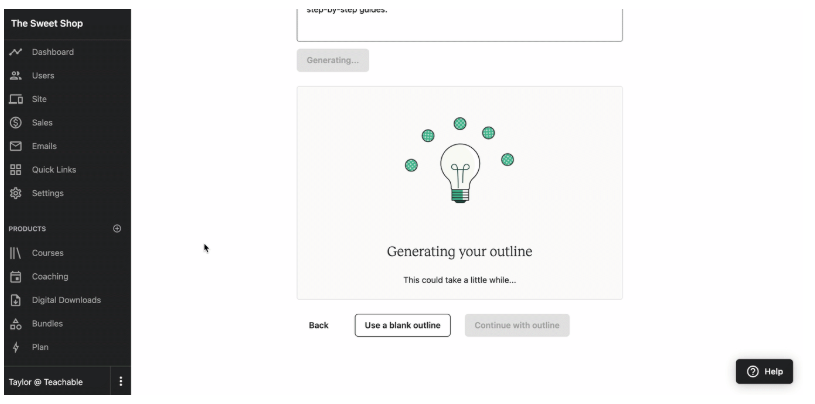
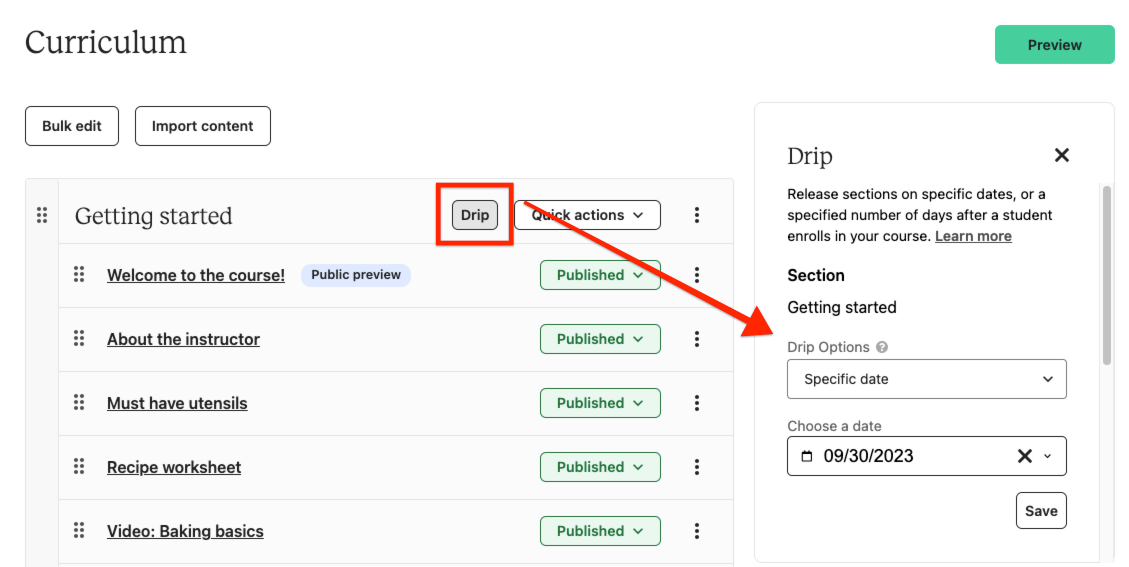
The catch is in how much control you actually get. Teachable’s drip feature only lets you unlock lessons after a set number of days. What it doesn’t allow is more advanced compliance, like requiring a quiz pass or a percentage of video watched before the next module opens.
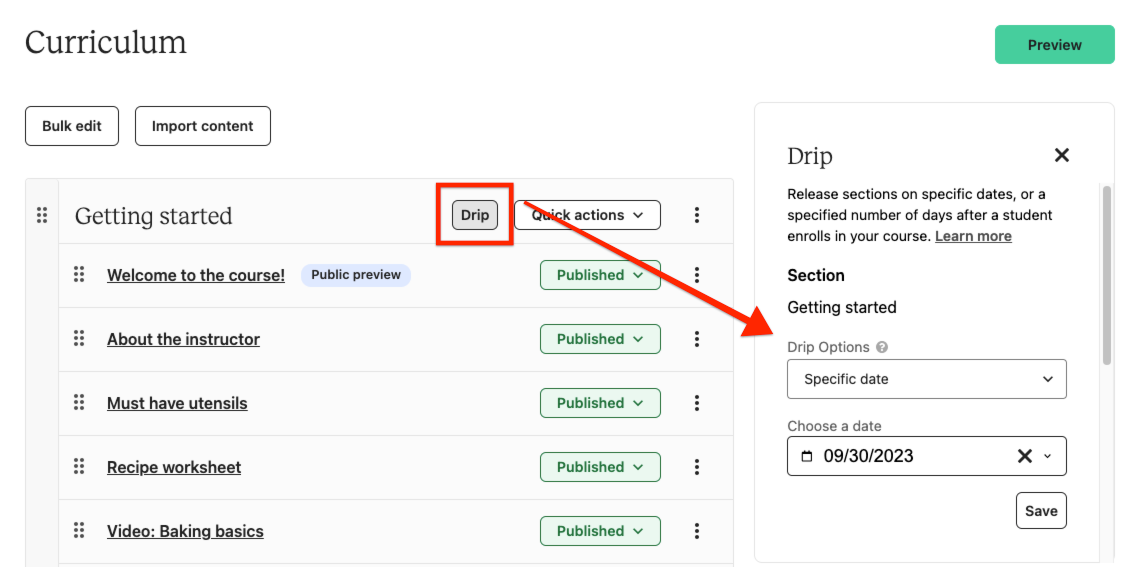
You won’t find internal surveys or advanced types of assessments. And for feedback, you’ll need external tools like Google Forms.
The customization here is limited. You can play with colors, upload logos, and even dig into HTML and CSS (if you have the skills). But it gives you a single default theme ,and that means it’s not flexible enough.
Where Teachable wins is ease of use. The UI is intuitive, and you can tweak lesson settings without digging through the full curriculum. That kind of simplicity is helpful if your priority is getting a course live quickly.
Thinkific’s Course Builder
Thinkific covers the basics too (drag-and-drop building, bulk uploads, and standard quizzes), but also gives you more room to control how the course is structured. It also helps you generate outlines powered by AI. But its advantage is the variety of lesson types and the ability to structure learning paths.

You can set prerequisites (e.g., quiz pass or video watch percentage before moving ahead), run cohort-based programs, and mix self-paced modules with scheduled sessions. Advanced compliance settings make it easier to enforce progress, not just time-based unlocks.
Thinkific also has a video library: upload once, reuse anywhere without re-uploading. It sounds small, but it saves time. Its presentation lesson type even lets you import a slide deck and record narration slide-by-slide, no extra software required.

Source
Assessments are stronger here, too. Alongside quizzes, you’ll have surveys and assignments. You can add Brillium for pro-level, timed exams with analytics (available on higher tiers).
The certificates are customizable, with templates and support for external providers like Accredible.

Another plus is templates. Thinkific continues to add new ones (from fitness to DJ courses), so you’re not stuck with a generic look. The redesigned course player also feels more modern than Teachable’s, with improved branding options, including logos.

The bottom line here is that Thinkific is for creators who want more structure, interactivity, and scalability in their courses.
Kajabi’s Course Builder
Kajabi leans into speed plus integration. The builder covers the fundamentals: drag-and-drop modules, drip schedules, quizzes, and auto-issued certificates.

But the difference is how tightly course creation ties into Kajabi’s marketing stack.In the same pane where you upload lessons, you can also bundle products, set launch discounts, trigger automations, or add offers. You don’t have to tab-hop or export.

That’s Kajabi’s real edge: the course itself plugs directly into funnels, emails, and affiliate programs.
Assessments are straightforward but effective. Multiple choice, multi-select, or pass/fail quizzes can be graded, and automations fire based on outcomes (e.g., failing a quiz triggers a resource email).

Certificates are auto-issued but visually basic compared to Thinkific’s customizable designs.
Coaching gets special treatment. Kajabi treats it as a native product type: schedule availability, connect your calendar, bundle sessions with courses, and keep notes all within Kajabi.

Thinkific supports coaching but only via external schedulers like Calendly or app integrations.
The course player itself is polished and consistent. It may not offer the breadth of lesson types Thinkific does, but it ensures smooth navigation and pairs tightly with automations to re-engage inactive students.
Like Teachable and Thinkific, Kajabi also comes with an AI course generator.
Here’s your takeaway:
- Teachable is the easiest starting point, but it's limited for structured learning.
- Thinkific gives the best balance of flexibility, structure, and customization.
- Kajabi offers smooth workflows with marketing baked in, but less depth on assessments.
Marketing and sales tools
Having a course is one thing, but getting people to buy it? That’s where most creators feel the pinch. Now, let’s look at the marketing and sales aspects.
Teachable’s marketing suite
With Teachable, you can send drip emails tied to course progress and simple notifications, but there’s no automation, segmentation, or nurture sequences.
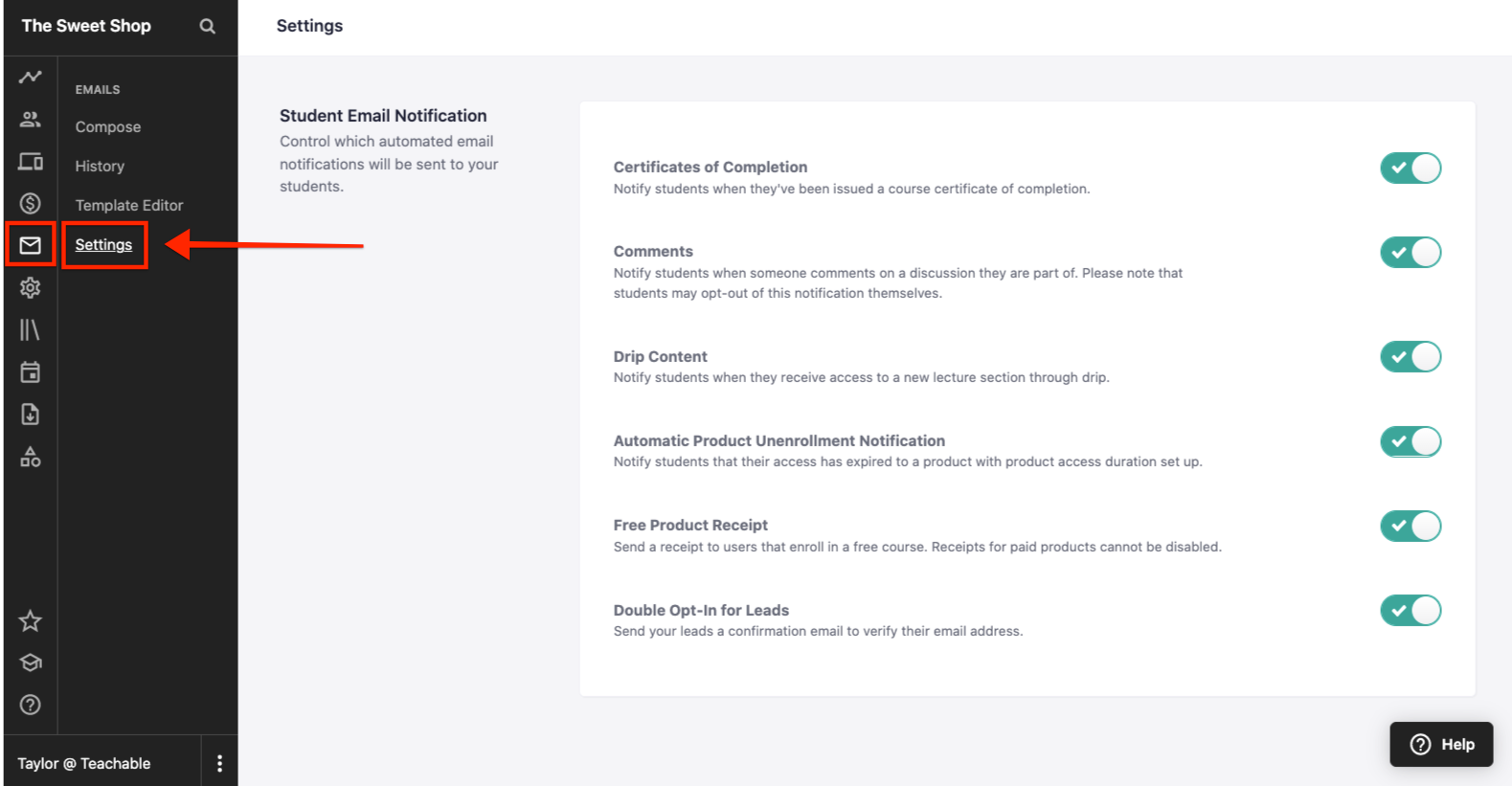
If you want welcome series, abandoned cart reminders, or lead nurturing, you’ll need Mailchimp, ConvertKit, or ActiveCampaign integrations.
Or if you want to use anything else, you’ll need Zapier (paid at ~$20/month for reliable workflows).
Where it falls short is automation and funnels. Teachable has no built-in funnel builder, no automation engine, and no real email marketing. You get sales pages, upsells, and order bumps, but no funnel builder or lead magnet automation. (Note: only one order bump per checkout.)
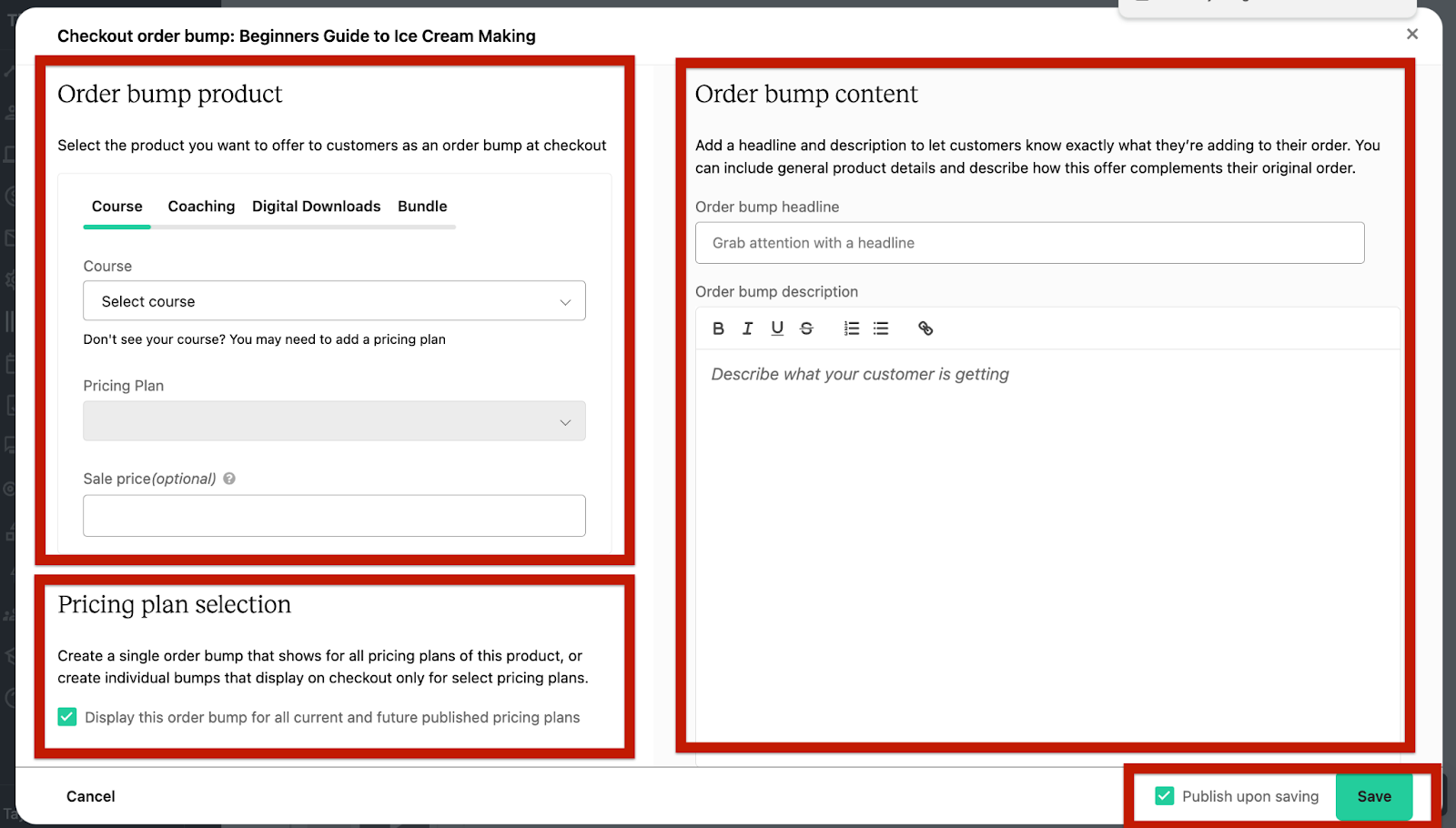
Want a multi-step launch? You’ll need an external tool like ClickFunnels, Leadpages, or Kartra.
Affiliate marketing here is simple but functional. You can assign affiliates to specific courses, set cookie durations, and even let affiliates stack codes with coupons.
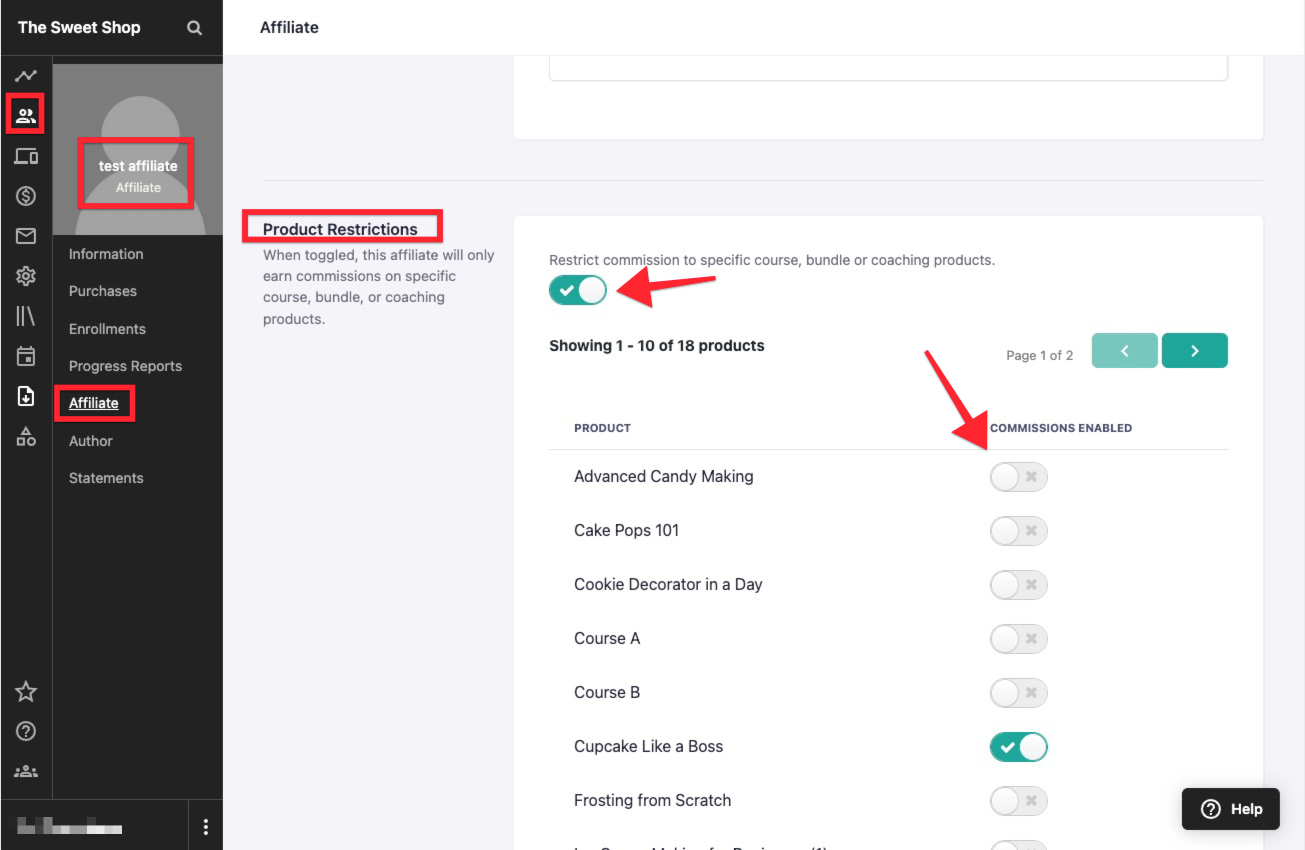
Nothing advanced, but it works if you’re starting out.
Teachable works if you’re fine with layering on external tools. If you want serious funnels or email automation, you’ll need to bring in third parties.
Thinkific’s marketing suite
Thinkific has been beefing up its marketing tools, and it shows. Emails used to be just basic broadcasts and notifications, but now Thinkific supports automated email sequences.
You can send a welcome series, segment by student behavior, and even recover abandoned carts.
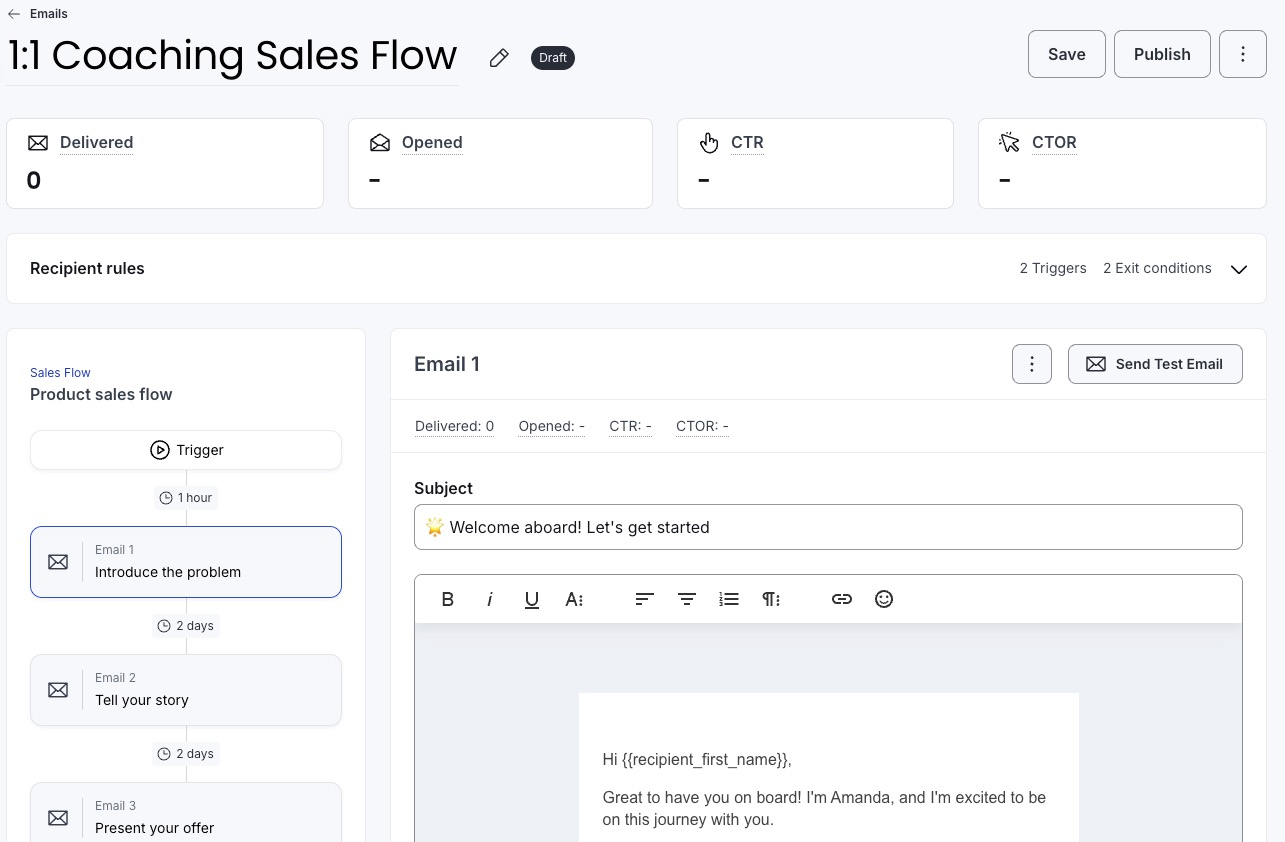
Still, the automation isn’t as advanced as Kajabi (no deep conditional workflows), but it covers most creator needs.
Thinkific added funnel templates, but they’re limited. You get three options (Free Lesson, Free Download, Sales Page).
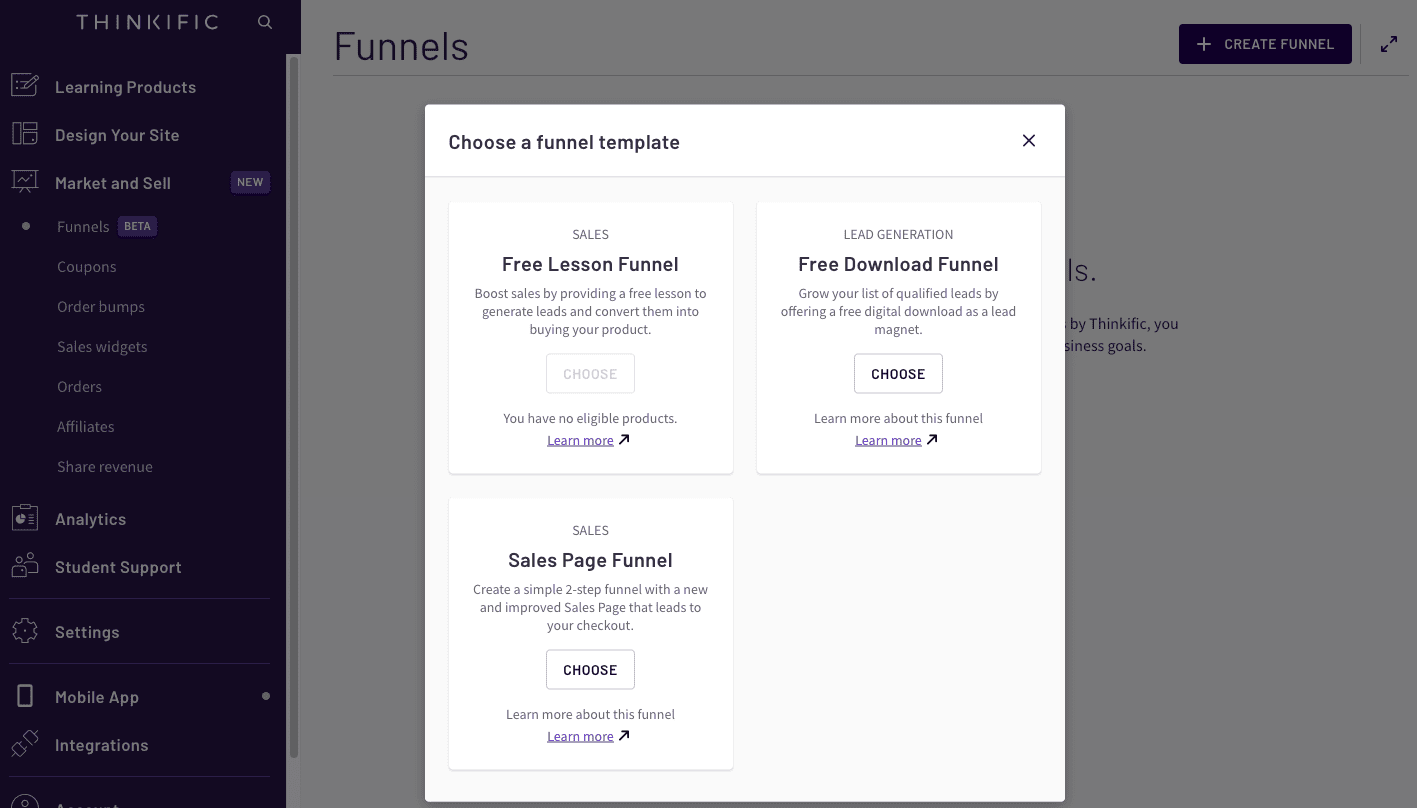
These are fine for simple lead capture or sales pages, but you can’t build multi-step pipelines. To scale up, most creators partner with external funnel builders.
Thinkific’s TCommerce system is more advanced than Teachable Pay. It supports order bumps, one-click upsells, BNPL (Affirm, Klarna, Afterpay), tax remittance, and even automated retries for failed subscriptions.
Abandoned cart emails are included, helping creators recover revenue without extra software.
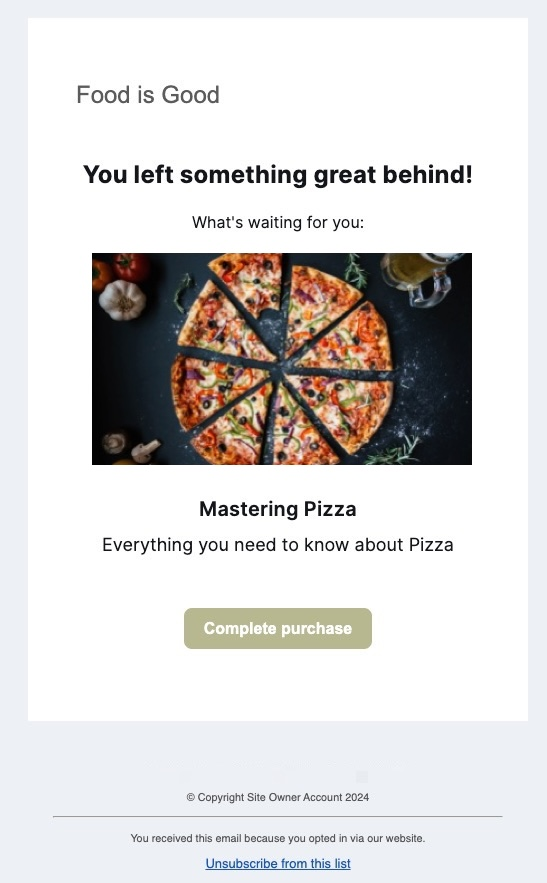
Affiliate marketing is available from the Basic plan. Thinkific’s system is minimal: lifetime recurring commissions, fixed cookies, and straightforward payout management.
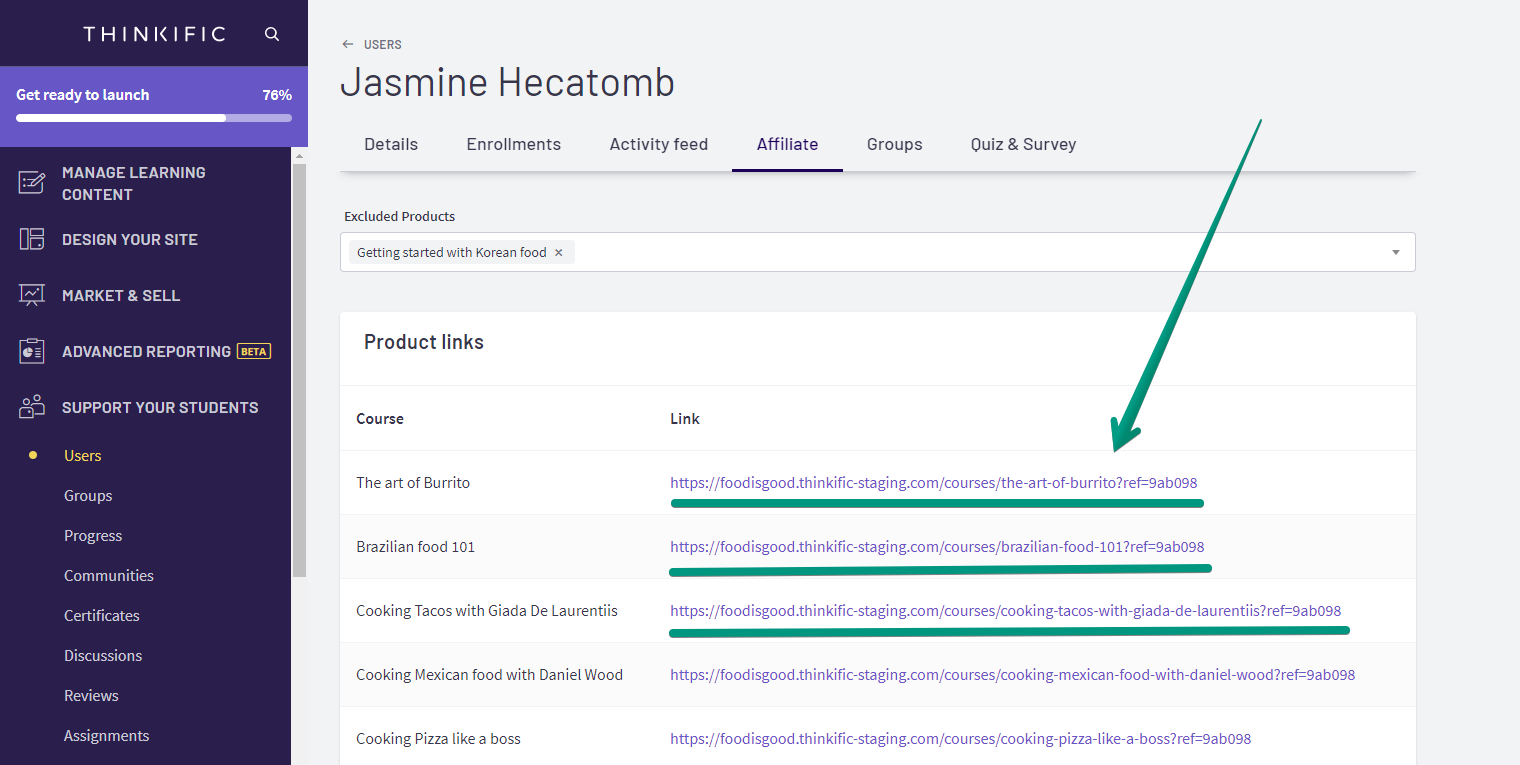
It works, but it doesn’t have Kajabi’s advanced tracking or custom sign-ups.
Integrations are Thinkific’s other edge. Direct integrations with Mailchimp, ConvertKit, ActiveCampaign, AWeber, Constant Contact, and over 90 other apps via its marketplace. You’re not locked into their native tools.

Thinkific sits in the middle ground. Better built-in automations than Teachable, but not as deep as Kajabi. Strong on payments and integrations, lighter on funnel sophistication.
Kajabi’s marketing suite
I think it’s safe to say that Kajabi is the marketing heavyweight of the three.
Email is full-featured. Drag-and-drop builder, segmentation, templates, analytics, automated sequences, and visual workflows. You can set “if-this-then-that” rules: if someone clicks a link, they’re tagged and moved into a different sequence
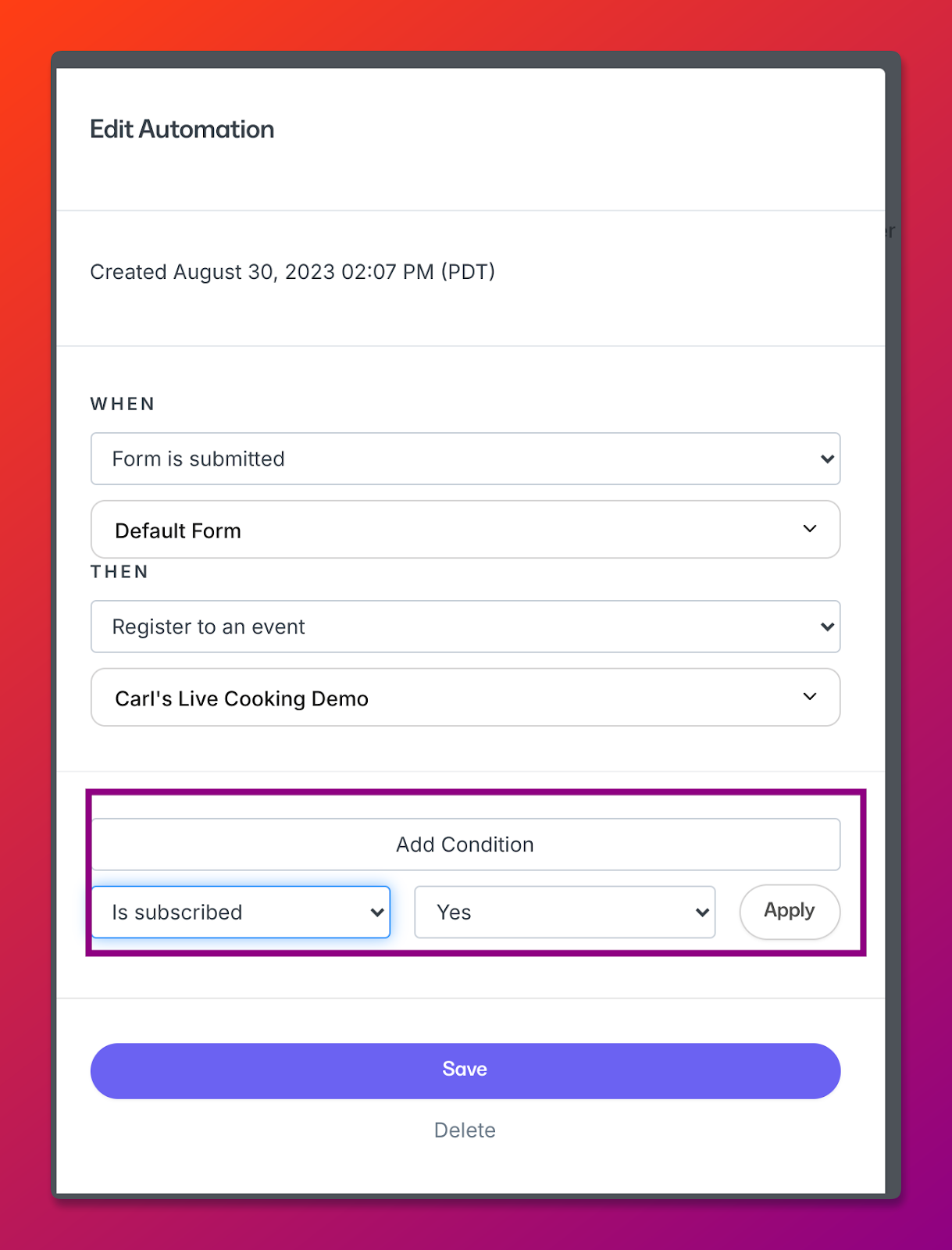
For many creators, Kajabi replaces Mailchimp or ConvertKit entirely.
Funnels and pipelines are where Kajabi stands out. You get pre-built blueprints for launches, webinars, evergreen challenges, freebies (and more). Choose a funnel, and Kajabi auto-generates your opt-in page, email sequence, and checkout flow.
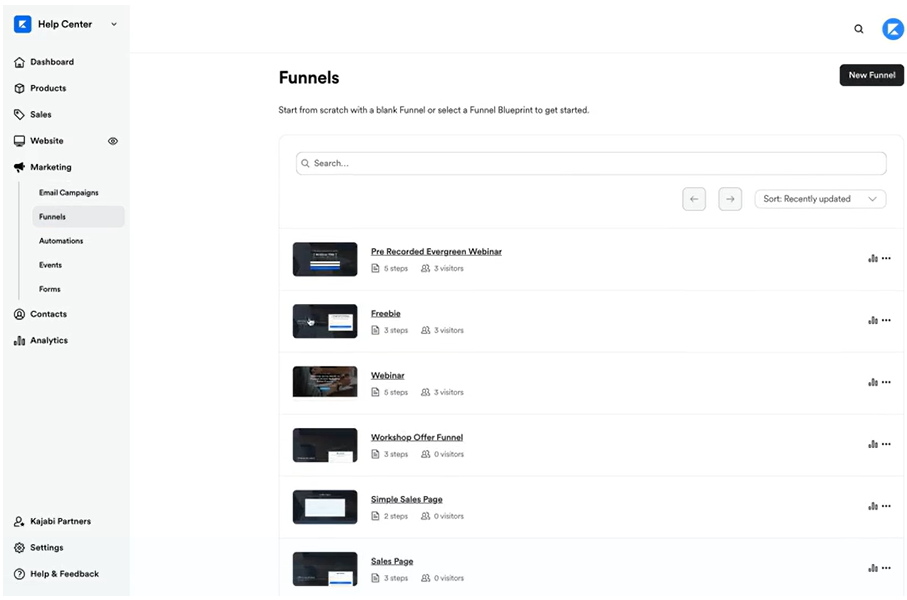
You can edit or expand the steps visually. Pipelines sync directly with Kajabi Live and Zoom for webinars and events.
Checkout is highly customizable. You can bundle products, add multiple upsells, create custom checkout fields, and add order bumps. And you can even collect custom data like “Where did you hear about us?” directly at checkout (without third-party tracking).
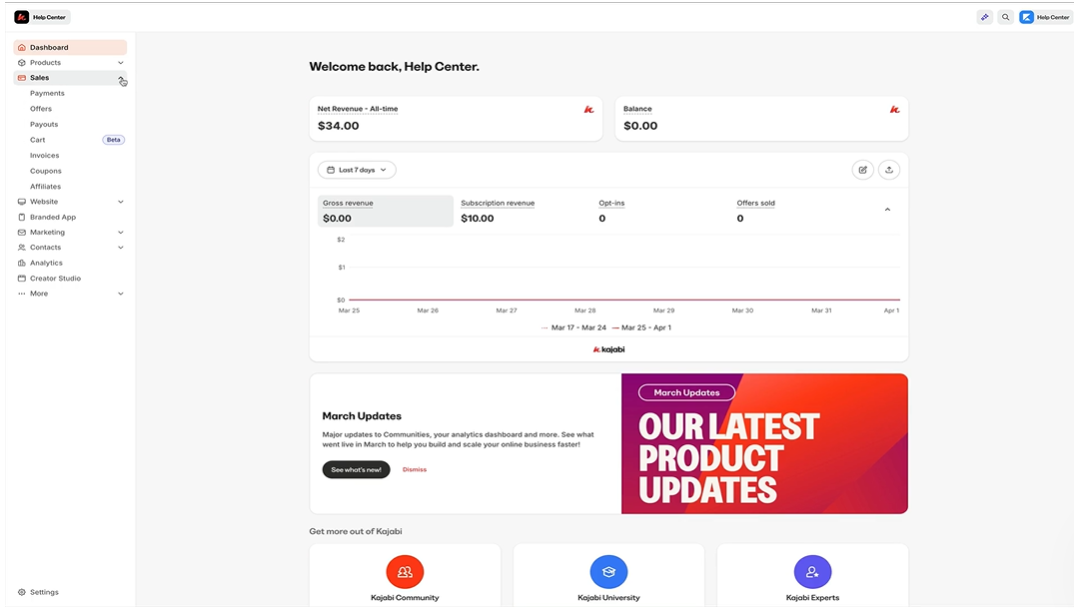
Affiliate marketing here is more advanced than both Teachable and Thinkific. Growth and Pro plans give you features like public affiliate sign-ups, variable commission rates, and detailed reporting on clicks and conversions.
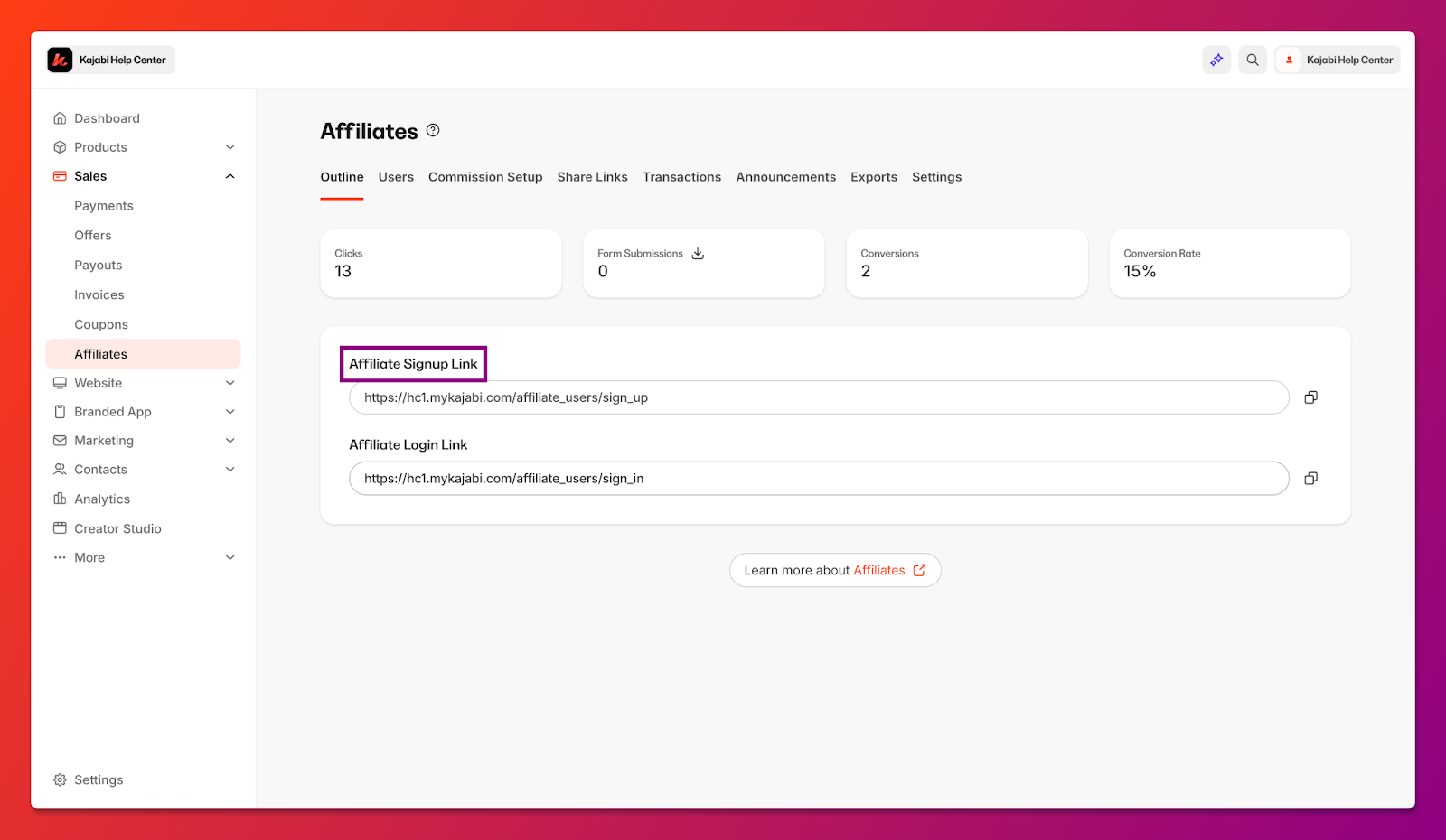
Automation is Kajabi’s strongest card. These are tied to quizzes, course progress, email behavior, and purchases. For example, failing a quiz and receiving a PDF resource, staying inactive for 60 days, and receiving a win-back offer. This marketing-to-learning loop is seamless.
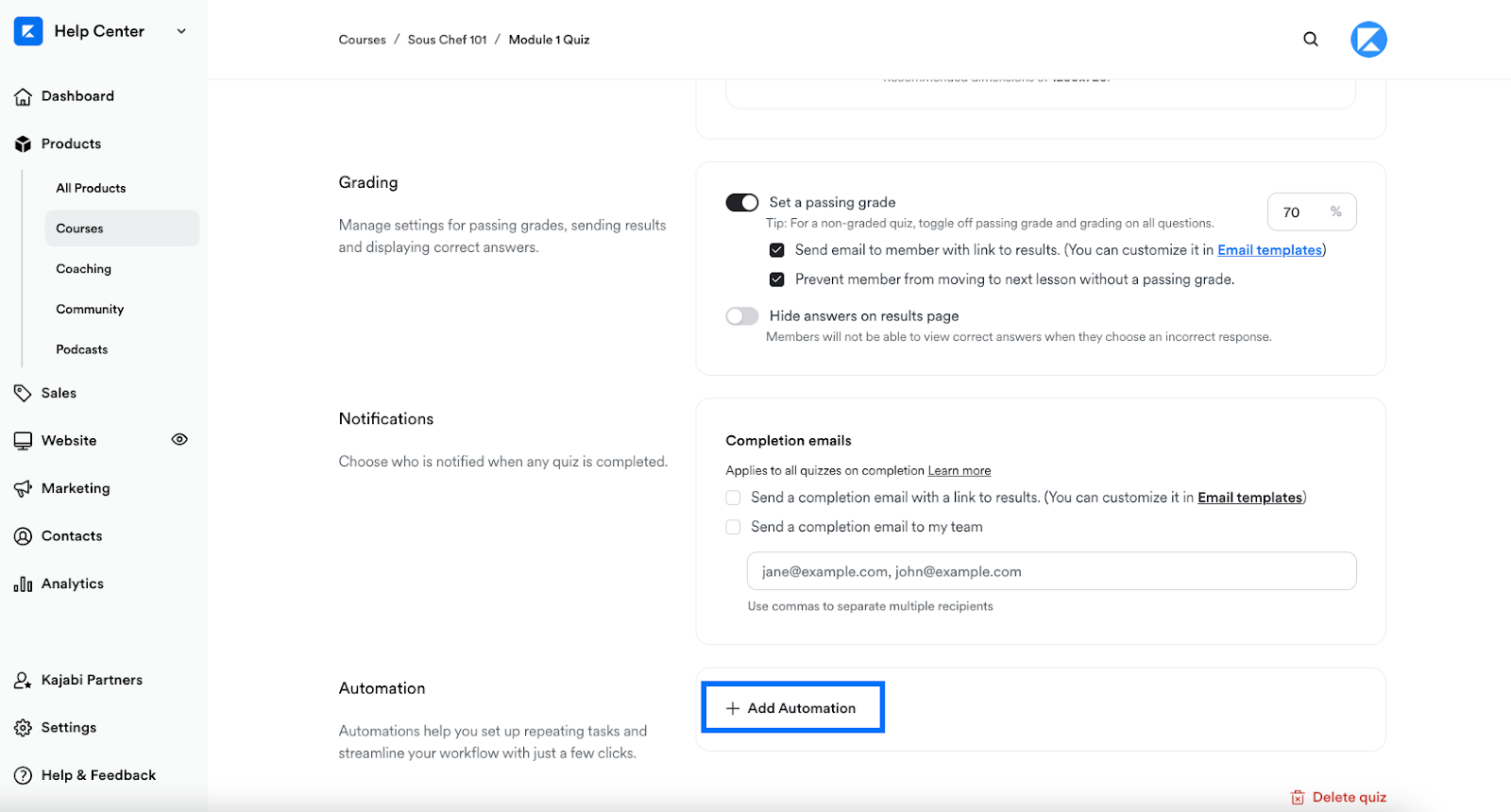
Kajabi offers the most complete marketing stack built in. No need to duct tape ESPs, funnel builders, or payment add-ons. But that power comes at a higher subscription cost.
Your decision depends on your needs. Choose
- Teachable for lightweight marketing; you’ll need external email and funnel tools.
- Thinkific to add automation and payments that cut down tool sprawl, but you’ll still need third-party support for real funnels.
- Kajabi for the most complete marketing stack. Built-in email, funnels, checkout customization, and automation (at a premium).
Website and page building
You need a public face for your business: a homepage, sales pages, and maybe even a blog. And it’s also about how much freedom you get to design those pages without calling in a developer. Here’s how Teachable, Thinkific, and Kajabi compare.
Teachable’s page builder
Teachable keeps things simple (maybe too simple). You can:
- Add a logo and favicon.
- Adjust fonts, colors, and basic branding.
- Create course sales pages with text, images, video, testimonials, and pricing.
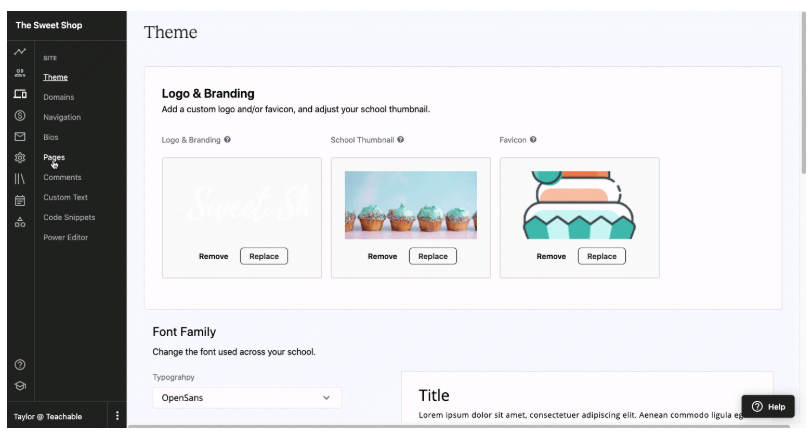
That’s pretty much it. You don’t get full-page templates, a proper site builder, or advanced customization. No blog support either.
Sales pages are functional but limited. You can add upsells or a checkout block, but you won’t find features like AI copy generation, A/B testing, or advanced styling.
Most creators end up pairing Teachable with WordPress or another page builder if they want more control.
Teachable’s website features are fast to set up, but with limits. They’re fine if you just need a landing page, but you’ll outgrow them quickly if design is important.
Thinkific’s page builder
Thinkific gives you more flexibility than Teachable, but it still isn’t as advanced as Kajabi.
You get three core website themes, with three or four style variants (12 combinations total). The site builder is drag-and-drop, with 20+ prebuilt sections like banners, CTAs, testimonials, and countdown timers.

It lets you connect a custom domain and adjust layouts, fonts, and colors. Advanced customization is also possible with Liquid code, although it requires technical expertise.
Sales pages stand out here: Thinkific’s AI-powered landing pages generate copy for you and tie directly into funnels.
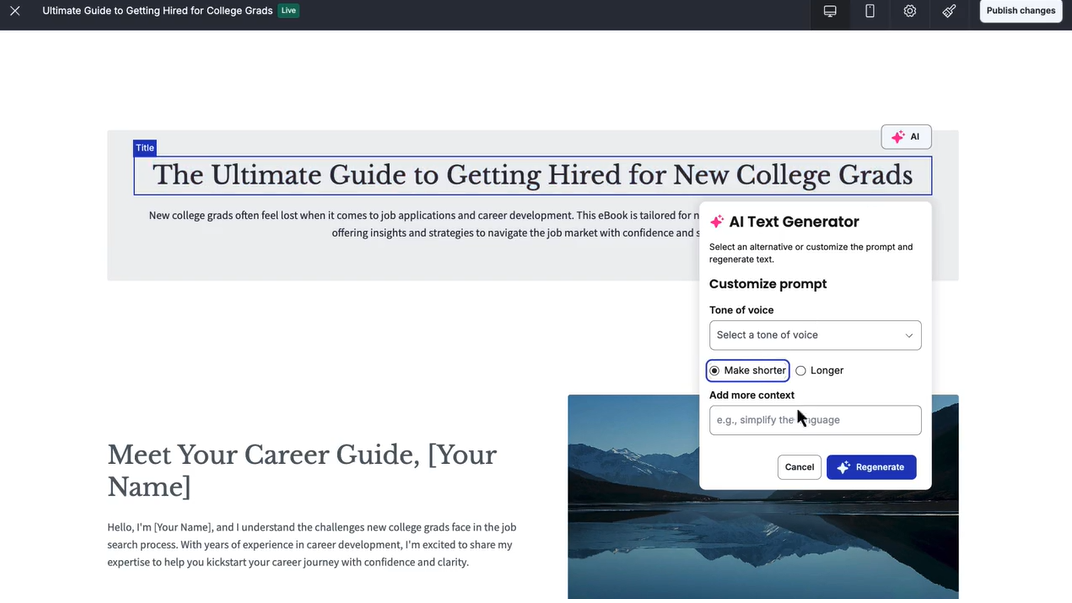
That means you can collect leads, trigger nurture emails, and upsell inside the same flow.
Page sections give you more flexibility: timers, CTAs, checklists, banners, testimonials. It’s easy to assemble a clean homepage or course catalog, but customization stalls if you want animations, padding control, or totally custom layouts.
Thinkific gives you enough tools for a decent branded site, especially if you’re okay working within the section templates. But it won’t replace a true website builder.
Kajabi’s page builder
Kajabi is the clear winner here. It ships with:
- 10+ professional website themes
- 20+ page templates for sales, opt-ins, webinars, and more
- A blog feature with SEO controls
- A drag-and-drop editor with 40+ block types
You can style individual blocks and sections (colors, spacing, background images, animations, even custom box shadows). Also, you can design full websites, landing pages, and checkout flows without touching code.
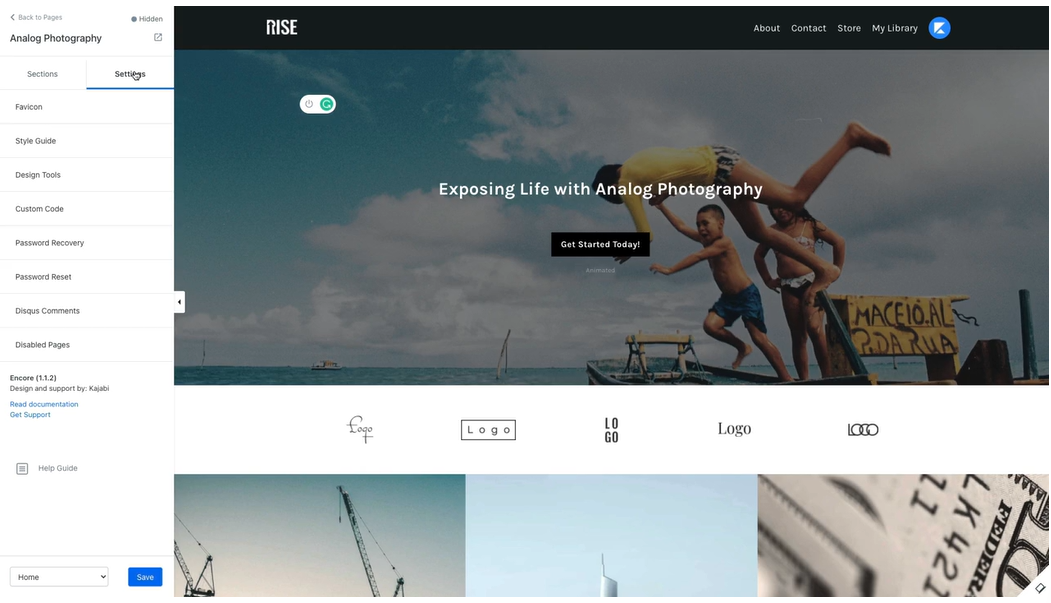
Kajabi also supports custom widgets (like animated cards or advanced CTAs). These cost extra ($5–$ 27/month per widget), but they expand functionality in ways that Thinkific and Teachable don’t.
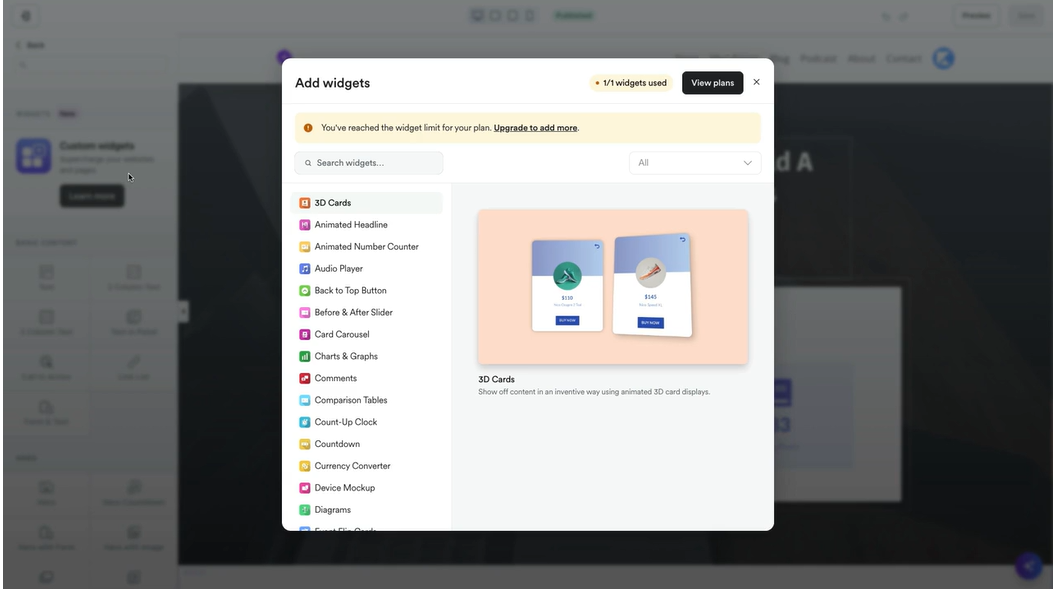
A unique feature here is A/B testing for landing pages. You can test different headlines, CTAs, or designs, and Kajabi tracks performance metrics like opt-ins, clicks, and conversions.
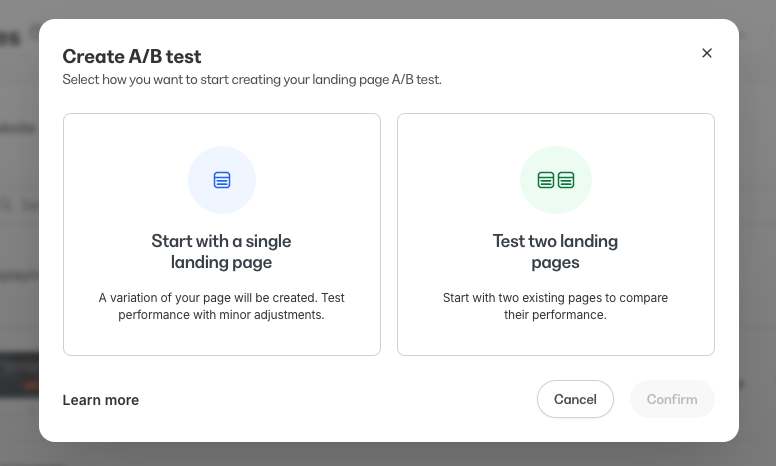
That’s marketing-grade tooling baked into the website layer.
Checkout and site pages integrate natively with Kajabi’s funnels and email automations, so the whole stack works seamlessly.
Kajabi’s website builder can replace WordPress for many creators. You can run a full-branded site, blog, and marketing funnels all within the platform.
To sum up this section,
- Teachable: Bare-bones, enough for a basic course sales page.
- Thinkific: More design freedom, plus AI landing pages, but limited beyond preset structures.
- Kajabi: Full website builder with themes, templates, blogging, and A/B testing (the most professional option).
FreshLearn: A smarter alternative you’re missing
By now, it’s clear: Teachable chips away at your margins with fees, Thinkific makes you lean on external tools for core features, and Kajabi charges enterprise-level rates for creators still in the early or mid-stage. This is where FreshLearn comes in.
FreshLearn combines Kajabi’s marketing power with Thinkific’s course-building flexibility and makes it affordable enough for any creator to start and scale.
- No hidden transaction fees.
- No restrictive student or course limits.
- No inflated monthly bills just to unlock essentials.
You start with a forever-free plan (up to 25 sales) and scale into paid tiers at $29, $46, $89, or $139/month (with our biannual pricing plans). Every plan includes unlimited courses and students, so you don’t worry about upgrading simply because your audience grows.
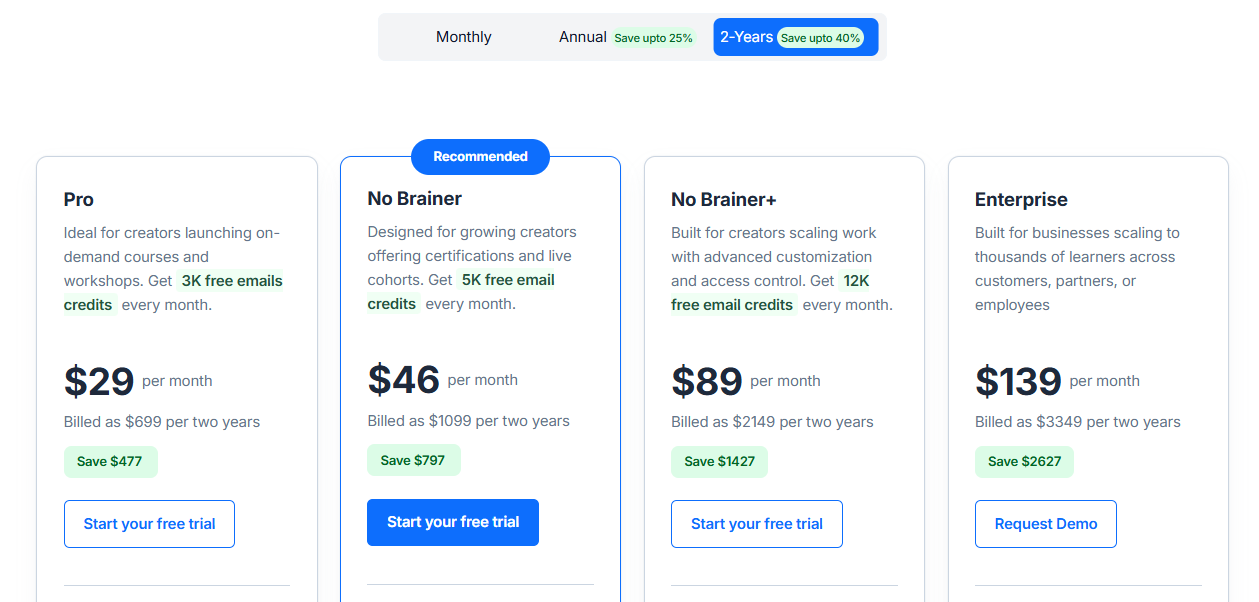
Unlike Kajabi’s lowest tier, FreshLearn’s core tools aren’t watered down; you get the essentials from day one. Here’s how FreshLearn wins:
A. 0% transaction fees on all plans
Keep every dollar you earn. Teachable takes 7.5% on its Starter plan, and even Thinkific penalizes you up to 5% if you don’t use its native payments.
FreshLearn charges zero platform commissions, so you only pay Stripe, PayPal, Razorpay, or PayU’s standard processing fees.
B. Unlimited courses and students
Many platforms throttle your growth until you upgrade. FreshLearn doesn’t. Whether you’re launching one course or a full academy, every plan includes unlimited students and unlimited courses.
That means you can expand without rethinking your pricing tier every time you scale.
C. AI-powered course builder & validator
Instead of starting from a blank page, FreshLearn’s AI agents generate course outlines, quizzes, branded sales pages, and even transcripts from a single prompt.
Not sure your course idea will sell? The AI Course Idea Validator drafts a waitlist landing page, tracks sign-ups, and gives you proof of demand before you invest weeks filming lessons. Neither Teachable nor Kajabi has this natively.

D. Built-in marketing suite
FreshLearn replaces half a dozen external tools. You get email campaigns, visual automation workflows, referral programs, coupon systems, and a blogging CMS built into the same dashboard.
No need for a separate ConvertKit subscription, or duct-taped Zapier flows. You’ll have one place to manage everything from leads to sales.
E. Actionable analytics in one dashboard
Track enrollments, watch-through percentages, quiz performance, revenue by product, and campaign attribution, all in one place. No juggling CSV exports or connecting BI tools just to see where students are dropping off.
F. Engagement tools that scale with you
Keeping students motivated is critical. FreshLearn includes gamification features like badges, leaderboards, and certificates to drive completion.
You can also build communities, add question banks for exams, and offer branded mobile apps to keep learners connected on the go.
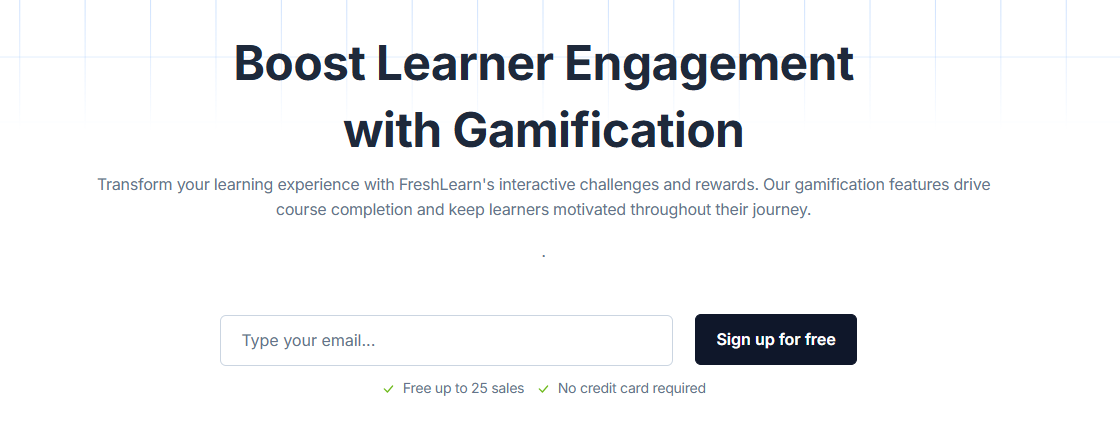
G. Switch to FreshLearn through free migration
Don’t let fear of switching keep you tied to a costly platform. FreshLearn offers free migration from any platform for yearly plan users. We’ve already helped over 1,000 creators move their courses, pages, blogs, members, and enrollments seamlessly.
If you’re on a monthly plan, migration is still available for a minimal fee. Either way, our team does the heavy lifting so you can keep teaching without disruption.
H. Flexible monetization options
Sell one-off courses, run memberships, create paid communities, bundle digital downloads, add order bumps, or split payments into installments.
FreshLearn processes it all with global payment support (Stripe, PayPal, Razorpay, PayU). You’re free to monetize in the way that fits your business model without plug-ins or platform lock-ins.
I. Conversion-first checkout pages
FreshLearn’s checkout flow is pre-built for conversions. You can add your logo, connect your domain, change colors, and include custom fields to track sources. Everything is designed to reduce friction and maximize sales.
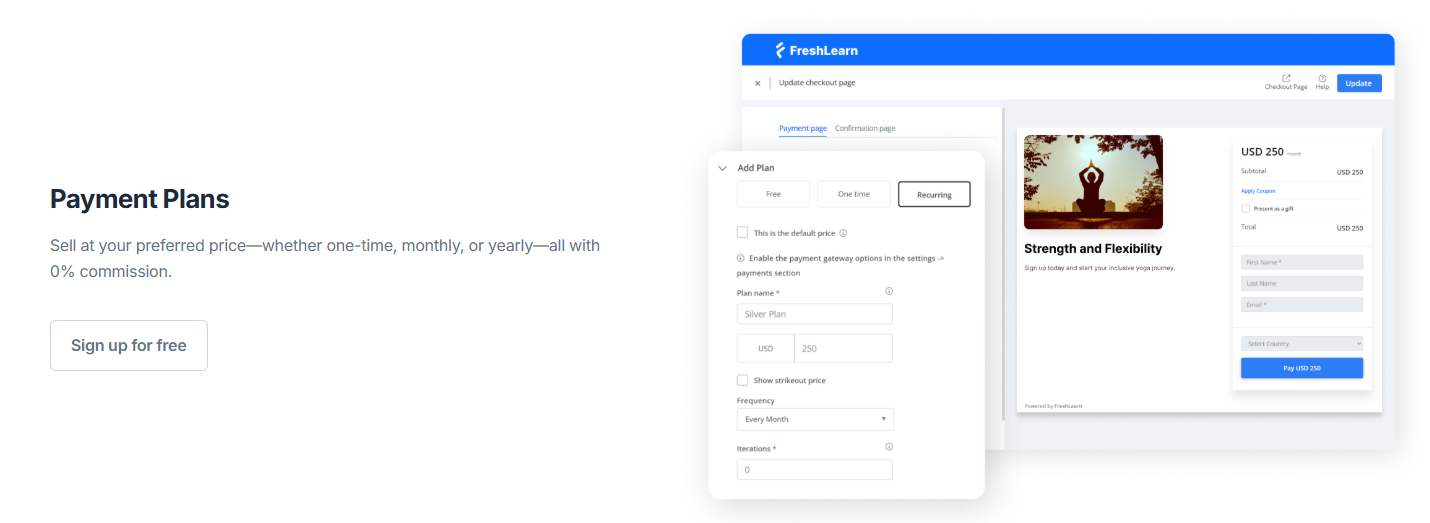
Proof, not promises: What migrating creators say
No matter which platform you’re coming from (Teachable, Thinkific, or Kajabi), our team moves your courses, student data, and even SEO-friendly URLs so your audience doesn’t miss a beat. Here’s what our users worldwide have to share about FreshLearn, especially after migrating from the three platforms:
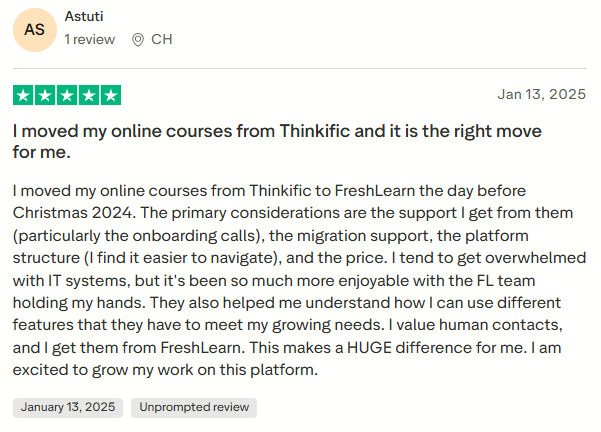
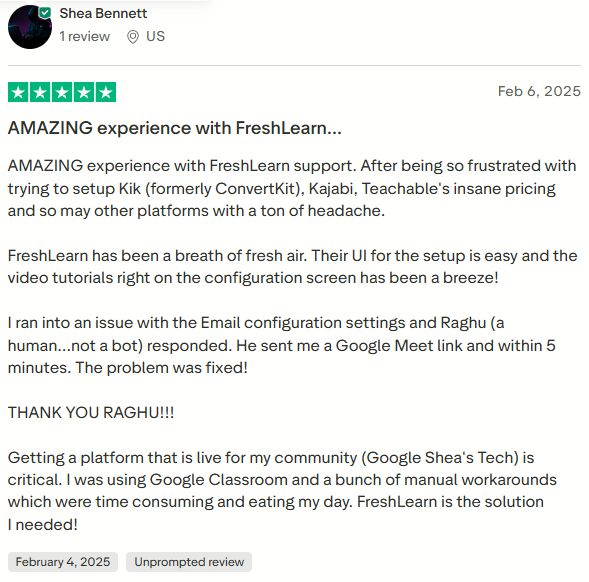
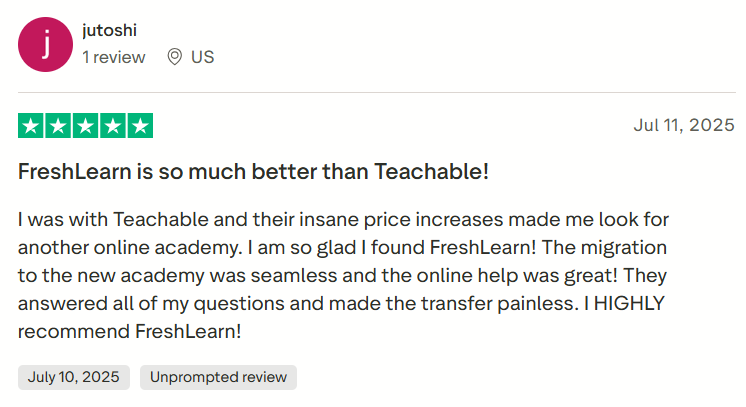
Final verdict: Who should use which platform?
You’ve seen the numbers, the builders, and the marketing stacks. Now let’s see who each platform actually makes sense for.
Choose Kajabi if…
- You’re already running a successful coaching program or digital product business.
- Your email list is in the thousands, launches are a regular part of your year, and you’d rather spend money than time managing multiple tools.
- You want a polished, all-in-one system and are comfortable paying a premium for convenience.
==> Choose Kajabi If...
- Your priority is delivering a strong learning experience (whether that’s structured courses, interactive lessons, or high-stakes assessments).
- You already rely on ConvertKit, Mailchimp, or HubSpot for marketing and don’t mind keeping it that way.
- You value student engagement and flexibility in course design above all else.
==> Choose Thinkific if…
- You’re a new solopreneur or hobbyist testing the waters with your first course.
- You don’t mind transaction fees or product caps in exchange for a quick start and a simple interface.
- You’re validating your idea before committing to a bigger investment.
Choose FreshLearn if…
You’re a growth-focused creator who wants it all: professional course delivery, built-in marketing automation, gamification, and zero hidden costs.
- You don’t want to keep paying Kajabi’s premium, and you’re tired of Teachable’s fees or Thinkific’s reliance on external apps.
- You care about keeping your margins healthy, avoiding surprise fees, and having the freedom to scale without artificial limits.
Your next step to course creation success
Choosing between Teachable, Thinkific, and Kajabi comes down to fit: your budget, your goals, and how much tech complexity you’re willing to manage. Each has strengths, but none fully eliminates the trade-offs.
With the global creator economy projected to hit $528.39 billion by 2033, the stakes are only rising. FreshLearn was built to give you everything you need without the hidden costs and limits (and a lot of room to grow).
Join 15,000+ creators who’ve already earned $30M+ on FreshLearn. Get started with your free plan today.
Frequently Asked Questions (FAQ)
1. What is the difference between Kajabi, Teachable, and Thinkific?
Kajabi is the all-in-one option: courses, email, funnels, and coaching all bundled in, but at a premium price. Teachable focuses on simplicity. It’s fast to launch but comes with product caps and transaction fees on lower plans. Thinkific gives you stronger course-building and assessments, but expects you to plug in third-party tools for marketing.
2. Is Teachable or Thinkific better?
Thinkific gives you more freedom in course design, assessments, and student management. Teachable is easier for beginners to set up, but it comes with fees and limits that add up fast. If you’re serious about growing beyond a test run, Thinkific is usually the stronger long-term choice.
3. What is the best online course platform?
There isn’t a universal “best,” but there is a best fit. If you want a platform that combines Kajabi’s all-in-one stack with Thinkific’s course flexibility, at a price point more accessible than Teachable, FreshLearn hits that sweet spot. Unlimited courses, 0% transaction fees, built-in marketing, and AI-powered course creation make it the best value for most creators today.
4. Is there a better platform than Kajabi?
Kajabi is polished, but its pricing puts it out of reach for many. FreshLearn delivers the same all-in-one convenience (courses, funnels, email, automations) at a fraction of the cost. And unlike Kajabi, there are no product caps or hidden transaction fees. Read our guide on why FreshLearn is a better Kajabi alternative to have a detailed comparison.
5. How can I move my course from Teachable to Kajabi?
You’ll need to manually migrate content and student data, or pay for a service to handle it. Kajabi doesn’t offer free migration.
FreshLearn, on the other hand, includes free migration on annual plans. That means your courses, students, and even SEO-friendly URLs come across without extra cost or downtime.

